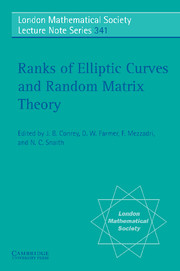Book contents
- Frontmatter
- Contents
- Introduction
- FAMILIES
- RANKS OF QUADRATIC TWISTS
- The distribution of ranks in families of quadratic twists of elliptic curves
- Twists of elliptic curves of rank at least four
- The powers of logarithm for quadratic twists
- Note on the frequency of vanishing of L-functions of elliptic curves in a family of quadratic twists
- Discretisation for odd quadratic twists
- Secondary terms in the number of vanishings of quadratic twists of elliptic curve L-functions
- Fudge Factors in the Birch and Swinnerton-Dyer Conjecture
- NUMBER FIELDS AND HIGHER TWISTS
- SHIMURA CORRESPONDENCE, AND TWISTS
- GLOBAL STRUCTURE: SHA AND DESCENT
- Index
The powers of logarithm for quadratic twists
Published online by Cambridge University Press: 10 November 2010
- Frontmatter
- Contents
- Introduction
- FAMILIES
- RANKS OF QUADRATIC TWISTS
- The distribution of ranks in families of quadratic twists of elliptic curves
- Twists of elliptic curves of rank at least four
- The powers of logarithm for quadratic twists
- Note on the frequency of vanishing of L-functions of elliptic curves in a family of quadratic twists
- Discretisation for odd quadratic twists
- Secondary terms in the number of vanishings of quadratic twists of elliptic curve L-functions
- Fudge Factors in the Birch and Swinnerton-Dyer Conjecture
- NUMBER FIELDS AND HIGHER TWISTS
- SHIMURA CORRESPONDENCE, AND TWISTS
- GLOBAL STRUCTURE: SHA AND DESCENT
- Index
Summary
Abstract
We briefly describe how to get the power of logarithm in the asymptotic for the number of vanishings in the family of even quadratic twists of a given elliptic curve. There are four different possibilities, largely dependent on the rational 2-torsion structure of the curve we twist.
Introduction
Let E be a rational elliptic curve of conductor N and Δ its discriminant, with Ed its dth quadratic twist. The seminal paper modelled the value-distribution of L(Ed, 1) via random matrix theory and applied a discretisation process to the coefficients of an associated modular form of weight 3/2. This led to the conjecture that asymptotically there are cEX3/4 (log X)3/8–1 twists by prime p < X with even functional equation and L(Ep; 1) = 0, where the 3/8 comes from random matrix theory, and the –1 comes from the prime number theorem.
We wish to determine a similar heuristic for the asymptotic for the number of twists by all fundamental discriminants |d| such that L(Ed, s) has even functional equation and L(Ed, 1) = 0. We find that the power of logarithm that we obtain depends on the growth rate of various local Tamagawa numbers of twists of E. Because of this, it is somewhat unfortunate that isogenous curves need not have the same local Tamagawa numbers. This is most particularly a problem when we have a curve with full rational 2-torsion and it is isogenous to one that only has one rational 2-torsion point; in this case, we should work with the curve with full 2-torsion.
- Type
- Chapter
- Information
- Ranks of Elliptic Curves and Random Matrix Theory , pp. 189 - 194Publisher: Cambridge University PressPrint publication year: 2007
- 4
- Cited by



